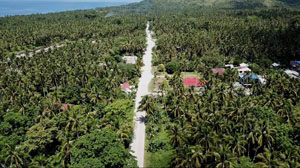“Our dream is now a reality,” said Barangay Binocaran Chairperson Rey Senaca during the turn-over rites of the P44 million 3.3-kilometer farm-to-market road (FMR). The rehabilitated and the concreted road connects Barangay Jubgan in the Municipality of San Francisco to Barangay Binocaran in Malimono, Surigao del Norte.
The Department of Agriculture-Philippine Rural Development Project (DA-PRDP) in Caraga through its Infrastructure Component handed over the completed project to the Local Government Unit of Malimono and the Provincial Local Government of Surigao del Norte last October 9, 2018.
During the turnover, Barangay Captain Senaca recalls the discomfort and hustle the previous road has brought them,
“For years, we have been dealing with a bad road that would look like a “Sungkaan” especially on rainy days,” Senaca said. “Residents would usually pay a higher amount than regular fare for their transport especially during rainy days in going to Surigao City,” he added.
The completion of the road has not only brought joy to farmers but also of multiple benefits. No more add-on for their fares going in and out of Malimono and a sigh of relief for farmers and fishers who now feel comfotable in their daily grind of transporting agricultural produicts to the market.
Surigao del Norte Vice Governor Arturo Carlos Egay Jr. said that the rough road in the area before was the reason why some Surigaonons would not even like to visit the beautiful coastal municipality.
“This project would surely give good results among the farming and fishing households. Probably one of these days, we’re going to see these families riding on their own vehicle because the hustle of a bumpy road is already gone,” Egay said.
Egay also emphasized to the recipients the responsibility in maintaining the project. “The local officials and the residents have a big role in keeping the road. This should be well-maintained so the next generation can still benefit and enjoy,” he said.
DA-PRDP continues to build infrastructures that will benefit the producers, traders and rural population in general through establishing FMRs, bridges, communal irrigation systems, and other infrastructures like production, processing, marketing, and postharvest facilities that support development and linking of priority commodity value chains in project areas.







